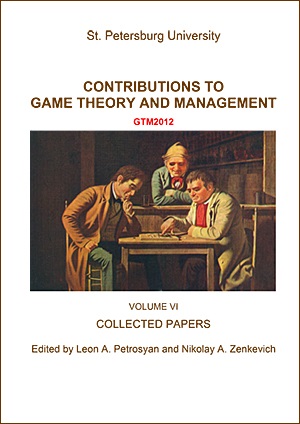Game-Theoretic Model on a Cognitive Map and its Tolerance to Errors in Input Data to Analyze a Conflict of Interests Between Russia and Norway in Barents Sea
Abstract
Some problems of complex control in the fields connected with public life (i.e., social-economic, political and other fields) include ill-structured control object. Situation appears ill-structured if the basic parameters have qualitative (not quantitative) nature, and their values are subjective expert evaluations. Cognitive maps serve to solve control problems for ill-structured situations. Cognitive map is a model representing knowledge of the expert (or a group of experts) regarding situation; this model is described in the form of weighted directed graph. The nodes of cognitive map correspond to those concepts being employed to describe the situation. The concept may be treated as a variable (for instance, "national defence capacity") which may have different values, such as "high", "low" and so on. Weighted arc is interpreted as direct cause-effect relationship between two concepts. Suppose several decision-makers (agents) take part in the process of decision making in an ill-structured situation given that the utility of each of them depends both on his self actions and the actions of the others, than interactions of the agents can be seen as a game on the cognitive map. In the game cognitive map represents a model of ill-structured control object and clearly describe the dynamics of the situation. The use of cognitive maps in the game gives more detailed and visual simulation of the environment of the conflict in the form of simple causal links, so as to describe the goals and strategies of the agents in terms of the environment which makes it more convenient to simulate the real conflicts adequately. Since the input data for the model are expert evaluation prone to subjectiveness, it is necessary to estimate the tolerance of model results to errors in input data. Experts evaluate the "importance percentage" of a target concept compared the others target concepts and the weight of edges in cognitive map as the type of the causal links and its strength. In this paper we consider the problem of model tolerance to errors in input data and illustrate it on the material of conflict of interests between Russia and Norway in the Barents Sea.
Keywords:
game, cognitive map, conflict of interests, dominant strategy, tolerance to errors
Downloads
References
Axelrod, R. (1976). Structure of Decision. Published by Princeton University Press, p. 395
Novikov, D. A. (2008). "Cognitive games:" A linear impulse model. In: Automation and Remote Control, Vol. 71., No. 4., pp. 718–730.
Roberts, F. (1976). Discrete mathematical models with application to social, biological and environmental problems. Rutgers University. Prentice-Hall, Inc. Englewood Cliffs, New Jersey.
Kulivets, S. (2010). Modeling of conflict situations with uncoordinated beliefs of the agents involving games based on linear cognitive maps. In: Automation and Remote Control, Vol. 72., No. 7., pp. 1568–1577.
Downloads
Published
How to Cite
Issue
Section
License
Articles of "Contributions to Game Theory and Management" are open access distributed under the terms of the License Agreement with Saint Petersburg State University, which permits to the authors unrestricted distribution and self-archiving free of charge.




